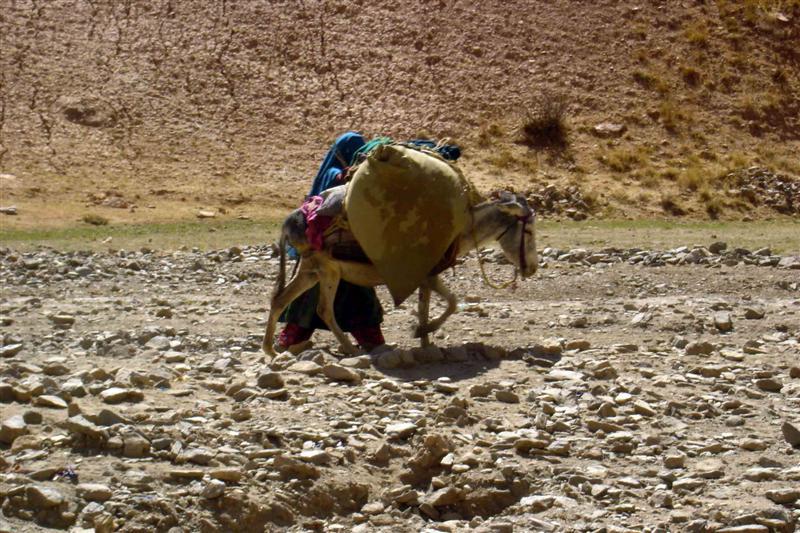BAMYAN CITY (Pajhwok): Fifty percent of women in central Bamyan province are doing hard manual labour, despite somewhat improvement in their situation over the past 15 years.
Widespread poverty, joblessness and cultural taboos are the major problems facing Bamyan’s women. However, hundreds of them are eking out decent livelihoods.
Those on job enjoy basic facilities and reasonable incomes. Fatima, a beekeeper, told Pajhwok Afghan News the agriculture department had provided her five bee boxes,
She acknowledged the support had enabled her to meet her financial needs to some extent. To her, this job is far better than working as cleaner in offices or homes.
She sold around 100 kilograms of honey and earned 80,000 afghanis last year. “For some women, bee farming is a very good business. I want all women to engage in such activities.”
Hamida, another woman who received 10 hens from a charity organisation, said she earned 80 afghanis daily from selling eggs.
“We know selling these eggs cannot solve our problem, but it somehow helps in meeting our basic needs,” she remarked.
Basma, 45, is another woman who peels timber in the capital of Bamyan and earns 200 afghanis as a day. She said the job was not permanent.
“This duty is hard for women, who should do tailoring and embroidery. They can also sell different items besides doing office work. Unfortunately, however, such jobs are not available.”
Ali Hassanzada, an Afghanistan Chamber of Commerce & Industries (ACCI) official, said women were currently busy working in 35 tailoring, cosmetic and handicraft shops.
“About 31 socioeconomic associations are registered with ACCI in Bamyan, and 15 women carry out economic activities on average under each of these associations.”
He called creation of job opportunities for women a major issue. But he made clear without the creation of industrial units, dairy and handicraft entrepreneurship, or other women support programme, work opportunities could not be created.
“It’s really difficult for women to do farming or herding, because they don’t have the ability to perform heavy work. Jobs that are not beyond women’s strength should be created for them.”
Abdul Rahman Ahmadi, the Bamyan governor’s spokesman, said: “This year we have recruited about 570 employees. Of them, 14 percent or 102 appointees are women.”
He added the governor house had ordered all departments to support women. “It has been decided that only women teachers be appointed girls’ schools. In co-education schools women and men have balanced representation. This positive discrimination will help create jobs for women.”
According to Ahmadi, about 17 percent of government employees in Bamyan are women. Efforts were ongoing to increase the figure to 25 percent, he continued.
The spokesman said women had been 23 shops for making handicrafts in Bamyan City. The move would resolve women’s problems, he believed
Sakina, a tailor by profession, said: “I am not content with my work because I can barely earn 5,000 to 7,000 afghanis a month. This is far from enough to meet my expenditure.”
Aziza Ahmadi, human rights director at women’s affairs department, said: “There are many issues in hiring women. Educated women are faced with even more acute problems. When a post is announced, hundreds of people participate in the test and interview.”
Lack of jobs in private and government sectors has resulted in increased poverty. Many families find it hard eking out a living. Some economists say lack of employment opportunities has worried for both men and women.
Mohammad Faiz, an expert, said thousands of young people had been forced to migrate to foreign countries due to continued unemployment and joblessness.
On the ever-increasing poverty graph in the country, he said: “It is dangerous that the economy is going down and poverty rising in the country. The government should take step to control the situation; otherwise more people will have to live below the poverty line.”
Abdul Wahab Mohammadi, agriculture and livestock director, told Pajhwok Afghan News over 2,600 women were provided work opportunities on different projects in the outgoing solar year.
He said according to the latest survey, the average level of poverty in the provinces was 36 percent while in Bamyan it rose to 57 percent, showing Bamyan was a poorer province than others.
Regarding women’s involvement in hard labour, he said over 50 percent females in Bamyan worked with male family members on farms due to extreme poverty.
He lamented that women’s inability to look after their children and family matters due to poverty and weak economic condition, which compelled them to work on farms alongside men.
mds/sns/nh/mud








GET IN TOUCH
NEWSLETTER
SUGGEST A STORY
PAJHWOK MOBILE APP